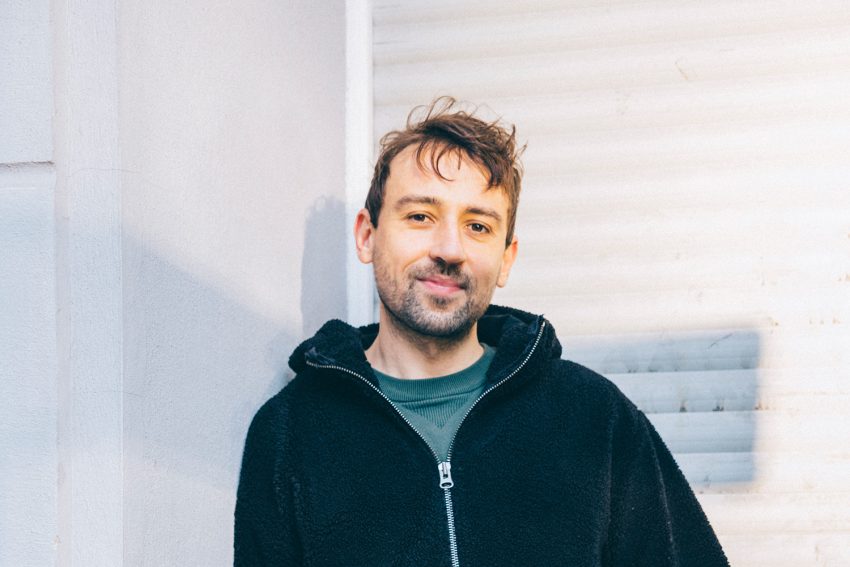On the trail of dyes Humboldt Fellow Dr. Lukas Patalag researches at the Institute of Organic Chemistry
In July 2021, Dr. Lukas Patalag started his one-year research stay at the Institute of Organic Chemistry at the Technische Universität Braunschweig – funded by a Feodor Lynen Research Fellowship of the Alexander von Humboldt Foundation. His host is Professor Daniel B. Werz.
Lukas Patalag’s research focuses on the long-standing field of dye chemistry. If one thinks of the burgeoning textile industry in the 19th century, it is a branch of research that was crucial for Germany as a chemical location, albeit one that has fallen somewhat out of fashion. As early as 1905, the Nobel Prize for Chemistry was awarded to Adolf von Baeyer for his work and synthesis on the blue “jeans dye” indigo.

Dr. Lukas Patalag is conducting research at the Institute of Organic Chemistry on a Feodor Lynen Research Fellowship from the Alexander von Humboldt Foundation. Picture credit: Angelina Vernetti
“Scientists, through their passionate tunnel vision, tend to regard their research as the navel of the world. If I followed in that tradition, I would say that we also owe life on earth to dyes and pigments,” the scientist explains with a grin. “Everything we harvest in terms of food, but also wood and oil, ultimately have their origin in the fact that dyes, as a kind of chemical interface, preserved the light of the sun for us and made it usable. You can also currently observe it in the colorful palette of autumn.”
Because of the physical processes involved, however, research on dyes is quite challenging and interdisciplinary, he said. “That’s one of the reasons, among others, why I might have so many postdocs behind me and have to delve deeply into (bio)physics and computational chemistry. Working toward such a broad scientific understanding, however, is not only varied, but also connects you to different ways of thinking and people.”
Fluorescent Dye “BOIMPY”
After initially challenging collaborative projects with Georg August University Göttingen in the field of sugar and lipid chemistry, Lukas Patalag developed the new fluorescent dye “BOIMPY” with Professor Werz at TU Braunschweig. The fluorescent dye was not a chance discovery, Patalag explains. “We developed the structure on paper, and I can even remember the moment when I came to Professor Werz’s office with it. He examined it critically, as usual, smiled a bit shaking his head and said, looks good, go for it! I am deeply grateful to him for the trust and freedom in research he always gave me.” From then on, Lukas Patalag now devoted himself mainly to research on luminescent or fluorescent dyes, and to this end, after completing his PhD in 2018, he joined Nobel Prize winner Professor Stefan Hell at the Max Planck Institute for Biophysical Chemistry in Göttingen to develop fluorescent dyes for the award-winning STED microscopy.
After brief stops in Würzburg with Professor Christoph Lambert and at the École Polytechnique Fédérale de Lausanne (EPFL) in Lausanne, he was finally drawn to Groningen (Netherlands) to work with Ben Feringa, another Nobel Prize winner. “The fact that I encountered two such outstanding researchers at once in my career is actually rather a happy coincidence. It resulted from the thematic connection and the practical proximity to Göttingen and Groningen,” says Dr. Lukas Patalag.
Current research
But after more than a decade of dye chemistry, the field is already quite thinned out, he said, with fundamental new molecular scaffolds like the BOIMPY being rather rare and surprising finds. “Today, the focus is more on dye aggregates, such as those used in leafy greens during photosynthesis,” Patalag comments on his current ventures. “It sounds almost esoteric, but if you bring two or more dye molecules close together, they sense each other and interact with light as a collective, so to speak.” What may seem esoteric, however, is rooted in the mysterious depths of quantum mechanics, he said.
Asked what he is currently researching, the fellow replies, “It’s still mostly basic research, and I sometimes find that a little unsatisfying. In my opinion, you can also conduct wonderful basic research with clear goals that promise social benefits. That’s why it would be nice to be able to commit our dyes to society at some point, perhaps even in dye-sensitized solar cells (so-called DSSCs),” the scientist explains. “In view of the ecological challenges, that would be a kind of solidarity ambition and would be a lot of fun for me. Hopefully, the DFG can also be convinced.”
About the person
Lukas Patalag was born in Katowice, Poland, and later grew up in Salzgitter, Germany, studying first medicine and then chemistry in Göttingen. He wrote his diploma thesis in 2011 under Professor Daniel Werz, who was still a postdoctoral fellow in Göttingen at the time, later became his mentor and now works at the Institute of Organic Chemistry at TU Braunschweig. “We are certainly two very different types, but perhaps that’s what explains the symbiotic collaboration,” says Prof. Werz, “There are many things on both sides that we appreciate about each other.”

